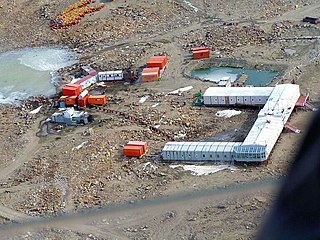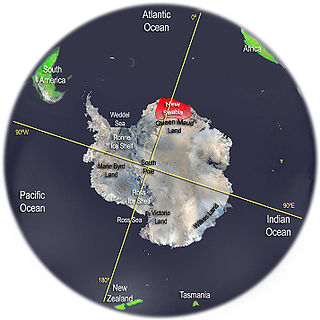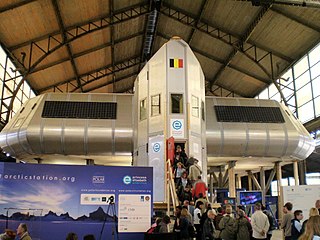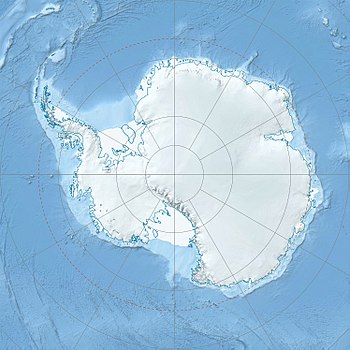
Maitri also known as Friendship Research Centre, is India's second permanent research station in Antarctica as part of the Indian Antarctic Programme. The name was suggested by then-Prime Minister Indira Gandhi. Work on the station was first started by the Indian Expedition which landed there in the end December 1984, with a team led by Dr. B. B. Bhattacharya. Squadron Leader D. P. Joshi, the surgeon of the team, was the first camp commander of the tentage at camp Maitri. The first huts were started by the IV Antarctica Expedition and completed in 1989, shortly before the first station Dakshin Gangotri was buried in ice and abandoned in 1990–91. Maitri is situated in the rocky mountainous region called Schirmacher Oasis. It is only 5 kilometres (3.1 mi) away from the Russian Novolazarevskaya Station.

New Swabia was a disputed Antarctic claim by Nazi Germany within the Norwegian territorial claim of Queen Maud Land and is now a cartographic name sometimes given to an area of Antarctica between 20°E and 10°W in Queen Maud Land. New Swabia was explored by Germany in early 1939 and named after that expedition's ship, Schwabenland, itself named after the German region of Swabia.

Multiple governments have set up permanent research stations in Antarctica and these bases are widely distributed. Unlike the drifting ice stations set up in the Arctic, the research stations of the Antarctic are constructed either on rocks or on ice that are fixed in place.

The Pole of Inaccessibility research station is a defunct Soviet research station in Kemp Land, Antarctica, at the southern pole of inaccessibility as defined in 1958 when the station was established. Later definitions give other locations, all relatively near this point. It performed meteorological observations from 14 to 26 December 1958. The Pole of Inaccessibility has the world's coldest year-round average temperature of −58.2 °C (−72.8 °F).

Troll is a Norwegian research station located at Jutulsessen, 235 kilometres (146 mi) from the coast in the eastern part of Princess Martha Coast in Queen Maud Land, Antarctica. It is Norway's only all-year research station in Antarctica, and is supplemented by the summer-only station Tor. Troll is operated by the Norwegian Polar Institute and also features facilities for the Norwegian Meteorological Institute and the Norwegian Institute for Air Research.

Troll Airfield is an airstrip located 6.8 kilometres (4.2 mi) from the research station Troll in Princess Martha Coast in Queen Maud Land, Antarctica. Owned and operated by the Norwegian Polar Institute, it consists of a 3,300-by-100-metre runway on glacial blue ice on the Antarctic ice sheet. The airport is located at 1,232 metres (4,042 ft) above mean sea level and is 235 kilometres (146 mi) from the coast.

Dome Fuji, also called Dome F or Valkyrie Dome, is an Antarctic base located in the eastern part of Queen Maud Land. With an altitude of 3,810 metres (12,500 ft) above sea level, it is the second-highest summit or ice dome of the East Antarctic Ice Sheet and represents an ice divide. Dome F is the site of Dome Fuji Station, a research station operated by Japan.

Princess Elisabeth Antarctica, located on Utsteinen Nunatak in Queen Maud Land, is a Belgian scientific polar research station, which went into service on 15 February 2009.

The Schirmacher Oasis is a 25 km (16 mi) long and up to 3 km (1.9 mi) wide ice-free plateau with more than 100 freshwater lakes. It is situated in the Schirmacher Hills on the Princess Astrid Coast in Queen Maud Land in East Antarctica and is, on average, 100 m (330 ft) above sea level. With an area of 34 km2 (13 sq mi), the Schirmacher Oasis ranks among the smallest Antarctic oases and is a typical polar desert.

Queen Maud Land is a roughly 2.7-million-square-kilometre (1.0-million-square-mile) region of Antarctica claimed by Norway as a dependent territory. It borders the claimed British Antarctic Territory 20° west and the Australian Antarctic Territory 45° east. In addition, a small unclaimed area from 1939 was annexed in June 2015. Positioned in East Antarctica, it makes out about one-fifth of the continent, and is named after the Norwegian queen Maud of Wales (1869–1938).

Norway has three dependent territories, all uninhabited and located in the Southern Hemisphere. Bouvet Island (Bouvetøya) is a sub-Antarctic island in the South Atlantic Ocean. Queen Maud Land is the sector of Antarctica between the 20th meridian west and the 45th meridian east. Peter I Island is a volcanic island located 450 kilometres (280 mi) off the coast of Ellsworth Land of continental Antarctica. Despite being unincorporated areas, neither Svalbard nor Jan Mayen is formally considered a dependency. While the Svalbard Treaty regulates some aspects of that Arctic territory, it acknowledges that the islands are part of Norway. Similarly, Jan Mayen is recognized as an integral part of Norway.

Jutulsessen is a nunatak in the Gjelsvik Mountains in Queen Maud Land, Antarctica. It is located in Princess Martha Coast, 235 kilometers (146 mi) from the King Haakon VII Sea. Jutulsessen is the site of the Norwegian research station Troll and the affiliated Troll Satellite Station, which has two radomes on top of the mountain. Troll Airfield is located in the vicinity.

Kohnen-Station is a German summer-only polar research station in the Antarctic, able to accommodate up to 28 people. It is named after the geophysicist Heinz Kohnen (1938–1997), who was for a long time the head of logistics at the Alfred Wegener Institute.
Belgium was one of the 12 countries that initially negotiated and signed the Antarctic Treaty.

Troll Satellite Station, commonly abbreviated TrollSat, is a satellite ground station located at Troll in Queen Maud Land, Antarctica. The earth station is owned by Kongsberg Satellite Services (KSAT), a joint venture between the Kongsberg Group and the Norwegian Space Center. The radomes are located on top of Jutulsessen, a nunatak area next to the research station at Troll. The research station is operated by the Norwegian Polar Institute, which also maintains the earth station. TrollSat started operations on 1 March 2007 and was officially opened on 20 January 2008.
Dronning Maud Land Air Network Project (DROMLAN) is a coordinated project between eleven countries with bases in Queen Maud Land, Antarctica to create a coordinated logistics service to reduce costs. The participating countries are Belgium, Finland, Germany, India, Japan, the Netherlands, Norway, Russia, South Africa, Sweden and United Kingdom. The services are operated using Russian Ilyushin 76, Norwegian and Swedish C-130 Hercules and Norwegian P-3 Orion aircraft, also occasionally visited by other types of aircraft The flights operate from Cape Town International Airport to Troll Airfield, with a flight time of up to nine hours for a Hercules aircraft, and five and a half hours for an Il-76.

The King Baudouin Ice Shelf in Dronning Maud Land, East Antarctica, is within the Norwegian part of Antarctica. It is named after King Baudouin of Belgium (1930-1993).

Monika Petra Puskeppeleit is a German physician, public health manager and scientific researcher with special interest in medicine of remote areas, especially polar regions. She is the first German medical doctor and station leader of the first all-woman team to overwinter in Antarctica.

The German Antarctic Expedition (1938–1939), led by German Navy captain Alfred Ritscher (1879–1963), was the third official Antarctic expedition of the German Reich, by order of the "Commissioner for the Four Year Plan" Hermann Göring. Prussian State Councilor Helmuth Wohlthat was mandated with planning and preparation. The expedition's main objective was of economic nature, in particular the establishment of a whaling station and the acquisition of fishing grounds for a German whaling fleet in order to reduce the Reich's dependence on the import of industrial oils, fats and dietary fats. Preparations took place under strict secrecy as the enterprise was also tasked to make a feasibility assessment for a future occupation of Antarctic territory in the region between 20 ° West and 20 ° East.























